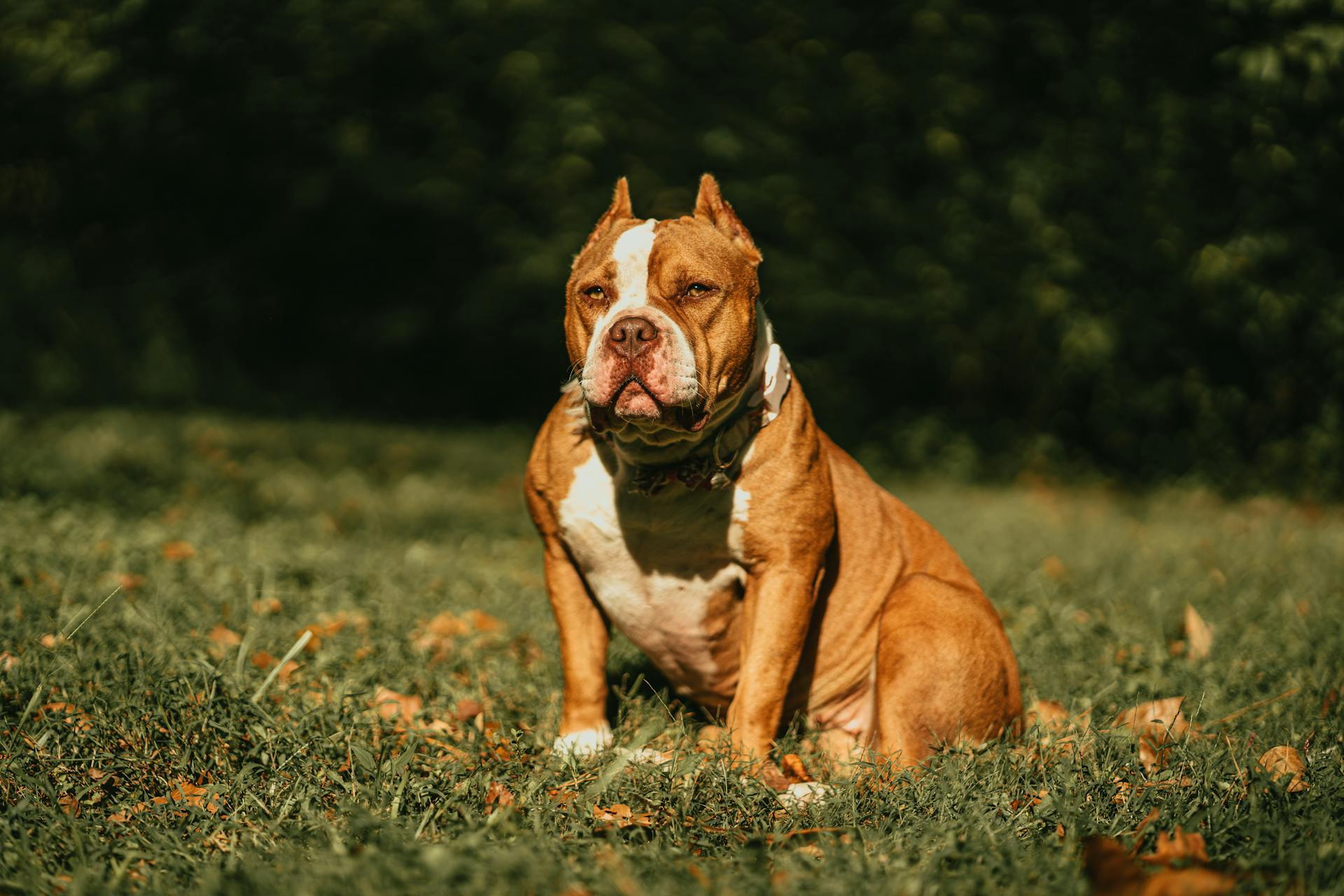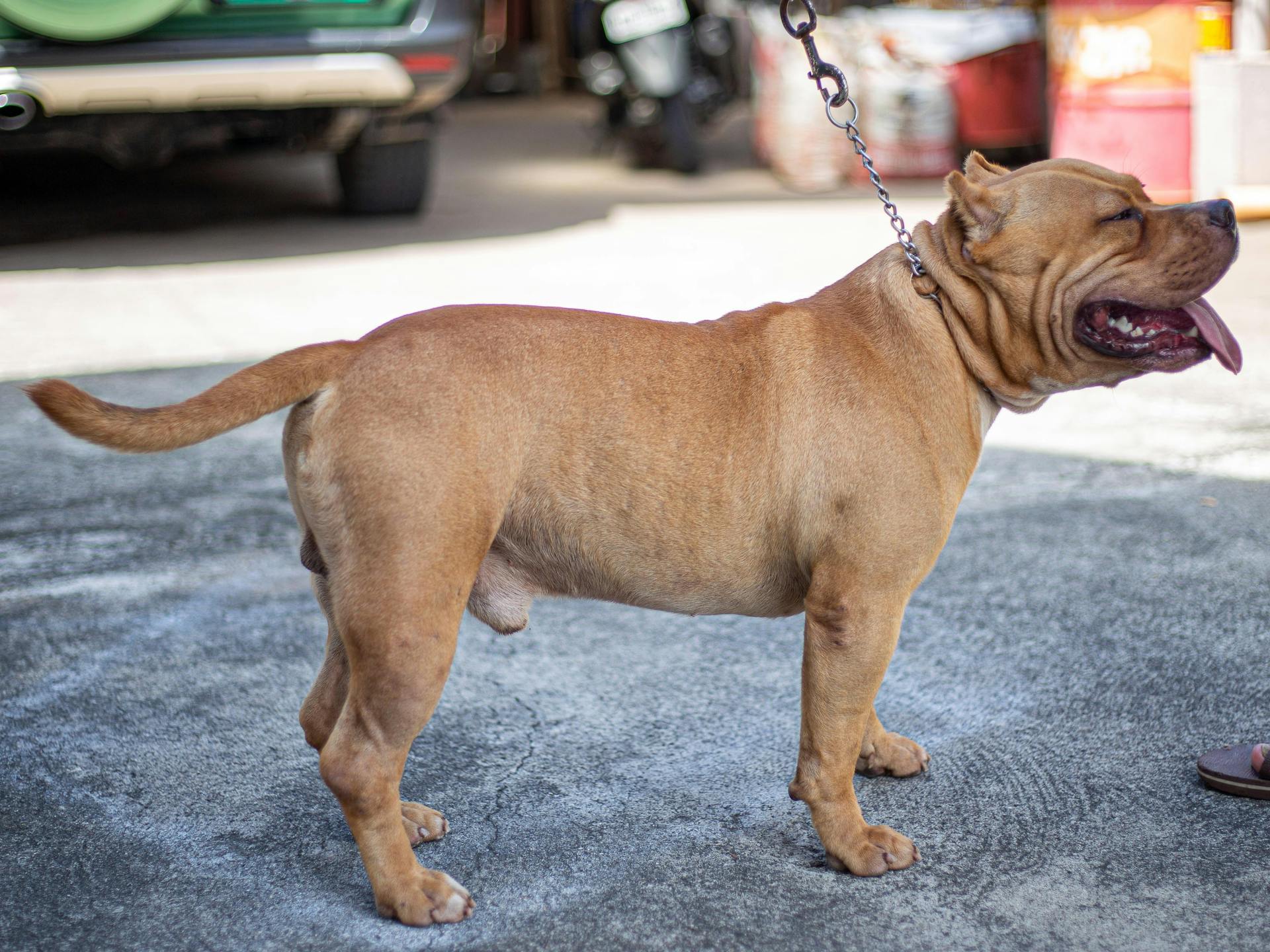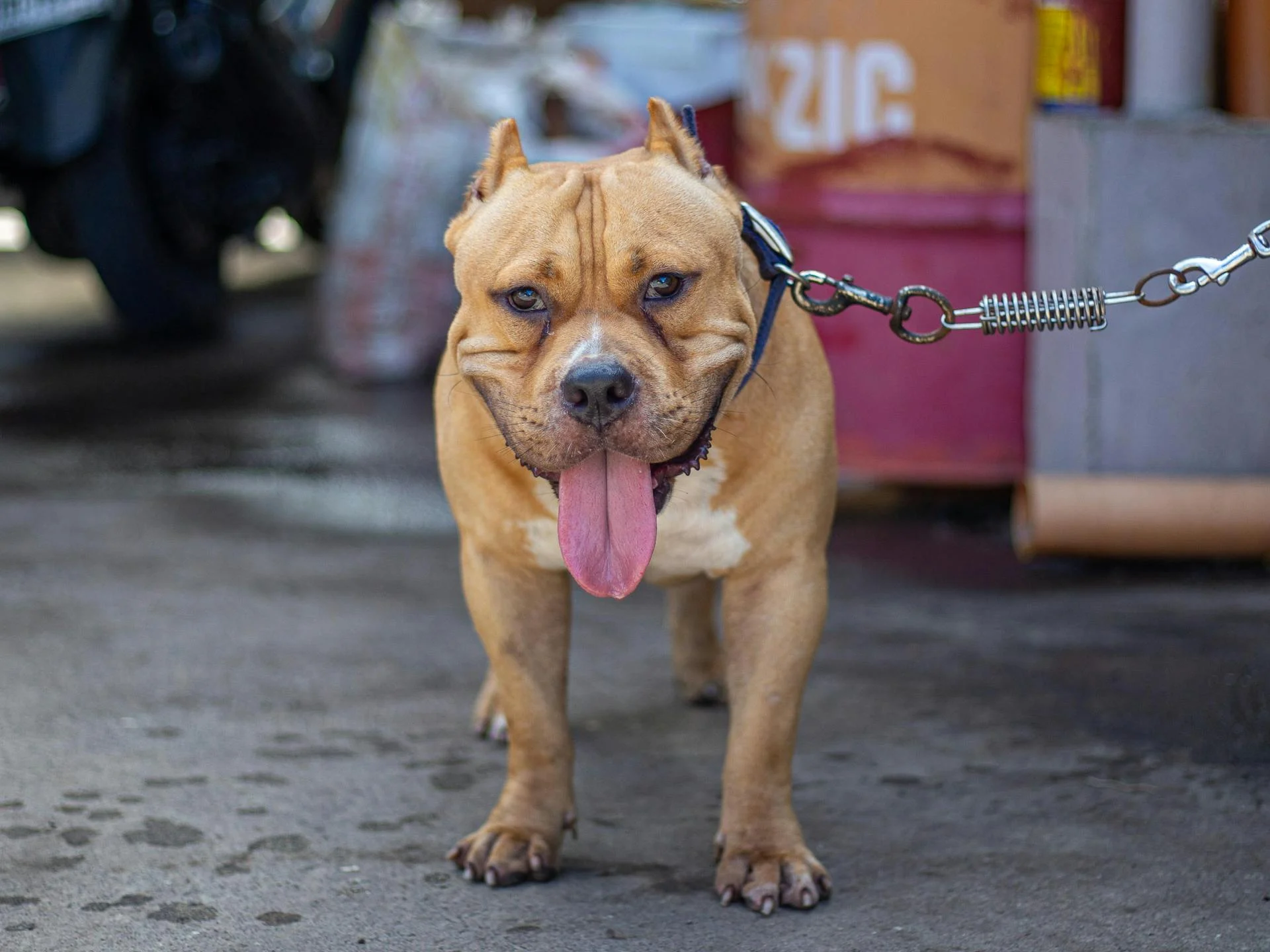
The American Bully is a breed that originated from the American Pitbull Terrier, but with a more muscular and compact body. This breed is known for its gentle and affectionate nature, making it a great family pet.
They typically weigh between 70-120 pounds and stand between 17-20 inches tall at the shoulder. Their short coats require minimal grooming, which makes them a low-maintenance pet.
In terms of temperament, the American Bully is often described as confident, outgoing, and energetic. They thrive on human interaction and require regular exercise to stay happy and healthy.
Curious to learn more? Check out: What Breeds Make up an American Bully
What Is a Bully?
So, you're wondering what is a Bully? Well, the American Bully is a fun dog breed to be around, known for its unique personality and build. They're small in height but have a big smile that's sure to win you over.
Their goofy personality makes them one of the funniest and most entertaining dogs to be around. They're confident dogs that display a sense of fearlessness, which is pretty impressive.
One of the things that sets American Bullies apart is their size. There are five different sizes of American Bully, ranging from the smallest Pocket American Bully to the largest XL American Bully. Here are the different sizes:
American Bullies are also known for their adaptability, they can thrive in different environments. They're friendly with other animals and love to play, socialize, and be around other animals generally.
Temperament and Training
The American Bully cross Pitbull is a unique breed that requires a firm yet positive approach to training. They have a playful nature, thanks to the terrier in them, and respond well to treats and praise as rewards.
You must be consistent and firm with your American Bully cross Pitbull to demand attention and respect. This breed is intelligent and loves to please their owners, making training a breeze if done correctly.
Their English Bulldog side can develop a barking habit, which you'll need to control as a puppy. The Bull Terrier side has a higher degree of wanderlust and prey drive, which should be handled when they're young.
Curious to learn more? Check out: How to Train an American Bully
This breed is often misunderstood due to the stigma surrounding the Pitbull breed. However, the reality is that American Bully cross Pitbulls are family-friendly pets that love their close circle and are suitable for children.
They are not the best guard dogs or watchdogs, as their primary personality trait is friendliness. They do well with other animals, including cats, and are quite social and friendly.
If you're considering an American Bully cross Pitbull as a pet, be prepared for the potential stigma that comes with it. But with patience, love, and proper training, this breed can thrive as a loving and loyal companion.
Suggestion: English Mastiff Cross Pitbull
Good Family Dogs?
The American Bully cross Pitbull can make great family pets, but it's essential to consider a few things. They are kid-friendly, but their size can be a concern, especially for small children who may be easily overwhelmed.
Their strong prey drive means they may not be the best fit for families with small pets like cats. Even if they're well-trained, their instinct to chase may be too strong to ignore.
As long as your children are a bit older, around 10 or older, the Bully Pit can make a wonderful addition to your family. They're incredibly affectionate and love to be showered with attention.
However, it's crucial to remember that their size and strength can be a hazard, even if they're not aggressive. They may unintentionally hurt smaller breeds or small children simply because of their size.
With proper training and care, the American Bully cross Pitbull can thrive as a family pet and become a beloved member of your tribe.
For more insights, see: American Bully Family Dog
Care and Maintenance
To keep your American Bully Cross Pitbull healthy and happy, regular meals are crucial. You'll need to monitor their caloric intake to prevent obesity, which can lead to chronic health conditions like diabetes.
Their relatively low activity level makes it easier to manage their diet, but it's still essential to provide regular meals and avoid free-feeding. This will help you keep track of their food consumption and adjust their diet accordingly.
As for grooming, don't worry too much - it's relatively low maintenance. You can expect some shedding, but regular brushing can help minimize the amount of hair around the house. Nail trimming is also important, especially since they're not overly active.
Readers also liked: What to Feed American Bully
Care and Maintenance

Regular meal times are a must for Bullypits, as they're not overly active and can easily put on pounds if not monitored.
This can increase their risk of chronic health conditions like diabetes, so it's crucial to keep an eye on their food intake.
Setting specific meal times instead of free-feeding can make it easier to manage their diet.
As a larger breed, Bullypits need relatively less food than smaller dogs, so be mindful of their portion sizes.
Their hybrid nature makes them prone to obesity, so regular weight checks and diet adjustments are essential.
Aim to provide 2.5 to 4 cups of high-quality dry dog food per day, adjusting the amount based on your dog's age and size.
Make sure the food you choose includes essential ingredients like omega-3 fatty acids, vitamins, chondroitin, and glucosamine to support their bone health.
As your Bullypit ages, switch to a dog food designed for their stage in life, such as a senior blend for older dogs or a puppy blend for newborns.
Explore further: American Bully Raw Diet
Exercise

Exercise is crucial for a Bullypit's overall health and happiness. You likely need to coax your Bullypit to get enough exercise, especially in light of his tendency to gain weight.
Daily walks are an excellent way to maintain your Bullypit's socialization skills and help him burn those extra calories. Sticking with walks on a leash is recommended since he isn't a dog-friendly breed.
A Bullypit requires a significant amount of exercise, with around 90 minutes of activity per day. If you don't fulfill this exercise requirement, your Bullypit will likely become destructive out of boredom.
Low-intensity walks and playing with toys inside the home are great options for a Bullypit's exercise routine. You can also kick it up a bit by taking your dog on runs or playing fetch if you're an active owner.
Regular exercise will help wear down your Bullypit's nails, making nail trimming easier. However, it's still essential to get your pup used to nail trimming as a puppy.
Grooming
Grooming is a relatively low-maintenance aspect of owning a Bullypit. You'll need to brush its coat about once or twice a week at most with a soft brush. Regular brushing can help control shedding, but be careful not to brush it every day or every other day as it can irritate the dog's sensitive skin.
Shedding is a normal part of life with a Bullypit, but you can minimize it with regular brushing. During shedding season, you may need to brush its coat more frequently to prevent excess hair from getting all over your home.
You likely won't need to bathe your Bullypit often, but when you do, use a damp washcloth or pet-safe wipes to clean it. Never give a Bullypit a bath more than once a month unless it gets skunked or in a similar situation.
Brushing your Bullypit's teeth once a day and trimming claws when needed is crucial, but may require some patience as they may fight these grooming needs at first. Be gentle and allow your dog to smell the clippers and toothbrush before touching their body with it.
Health and Conditions
As an owner of an American Bully cross Pitbull, it's essential to be aware of the potential health issues that may arise. Many of the at-risk health problems center around the skeletal and respiratory systems of your canine.
Hip and elbow dysplasia are common issues that can be expensive and painful to correct. Pre-health screenings for the hips and elbows by the Orthopedic Foundation for Animals can help identify these problems early on.
Cataracts, demodectic mange, and skinfold dermatitis are also potential health issues that may affect your American Bully cross Pitbull. Regular check-ups and a healthy lifestyle can help prevent or manage these conditions.
Here are some common health issues to watch out for:
- Hip dysplasia
- Elbow dysplasia
- Cataracts
- Demodectic mange
- Skinfold dermatitis
Health
Health and Conditions can be a major concern for Bully Pit owners. Many of the at-risk health problems center around the skeletal and respiratory systems of the Bullypit.
Pre-health screenings for the hips and elbows are a must, especially through the Orthopedic Foundation for Animals. This can help detect issues like hip and elbow dysplasia early on.
Take a look at this: Bully Dog Health Issues

Bully Pits are prone to certain health issues, including cataracts, demodectic mange, skinfold dermatitis, hip dysplasia, luxating patella, and cardiac issues. It's essential to be aware of these potential problems.
If your Bully Pit favors the Bulldog parent, you can expect it to need more medical attention. This is because Bulldogs have several inheritable illnesses that Bully Pits are likely to take on.
Hip dysplasia is a serious issue that can affect both Pitbulls and Bulldogs. It's highly likely for a Bully Pit to experience hip dysplasia in their life.
Some common health issues in Bully Pits include:
- Cataracts
- Demodectic mange
- Skinfeld dermatitis
- Hip dysplasia
- Luxating patella
- Cardiac issues
- Allergies
- Skin irritations
- Eye annoyance
- Heart disease
- Breathing difficulties
Are They Dangerous?
The XL bully's reputation for being a potentially deadly breed has sparked heated debates. Six of the 10 fatal dog attacks in the UK last year were linked to XL bullies.
Some people believe that the XL bully's strength and size make any attacks or bites more likely to be serious.
Bully Watch estimates that XL bullies are responsible for about 44% of attacks this year.
Campaign groups think the XL bully is inherently dangerous due to potential inbreeding, which may exaggerate behaviors like aggression.
On the other hand, animal welfare charities like the RSPCA, Blue Cross, and the Kennel Club argue that dogs should be judged on their actions, not their breed.
See what others are reading: How to Breed American Bully
Training and Behavior
Training an American Bully cross Pitbull requires a firm yet positive approach. They have a playful nature and can be sensitive to harsh reprimands, so use treats as rewards instead.
Bully Pits are highly intelligent and love to please their owners, making them some of the easiest dogs to train. They quickly pick up on commands and are more than happy to follow what you're saying.
To train your Bully Pit effectively, use positive reinforcement and be firm and consistent. Avoid being aggressive, as this can lead to unwanted behavior. Once your Bully Pit views you as the alpha, training is actually very easy.
Here are some key training tips for Bully Pits:
Bully
Training a Bully can be a unique situation, but with the right approach, it's a breeze. Bully Pits are highly intelligent animals that love their owners and quickly pick up on commands.
To get your Bully to listen, you must be firm and consistent, establishing yourself as the alpha. If you're aggressive, they'll either lash out or cower away, so use positive reinforcement like treats and praise instead.
Bully Pits have a playful nature, so they need to be kept engaged and active. A daily exercise routine of at least 40 minutes can help burn off excess energy and keep them focused.
Here are some key characteristics of a Bully's personality:
- Confident and fearless
- Affectionate and loving with their family
- Friendly with other animals
- Playful and energetic
- Protective around the family
- Adaptable and loyal
As a Bully owner, you'll need to be prepared for the potential stigma surrounding these breeds. However, with patience, consistency, and positive reinforcement, you can overcome this challenge and develop a strong bond with your pet.
Remember, Bully Pits are sensitive to harsh reprimands, so it's essential to use gentle yet firm training methods. With time and effort, you'll find that training your Bully is a rewarding experience that brings joy and companionship to your life.
Discover more: American Pitbull Terrier Training
Training and Behavior
Training and behavior are closely linked, and understanding how your dog learns and responds to different situations is key to developing a strong bond with them.
Positive reinforcement is a powerful tool in shaping your dog's behavior, as it associates desired actions with rewards, such as treats and praise.
Dogs learn quickly through repetition and consistency, so establishing a routine and sticking to it is essential for good behavior.
A well-trained dog is more likely to listen to commands and respond to cues, making walks and outings much more enjoyable for both you and your dog.
Consistency is key when it comes to training, as dogs thrive on predictability and clear boundaries.
Dogs are highly social animals and learn from their pack, so socialization is crucial for developing good behavior and reducing anxiety.
With patience, persistence, and positive reinforcement, you can help your dog develop good behavior and a strong bond with you.
Discover more: Mejor Alimento Para American Bully
Visual Differences
The American Bully cross Pitbull, also known as the Bullypit, can be quite deceiving at first glance. While they may look similar to other Pitbulls, they are actually quite different.
Their size can vary greatly depending on the size of the American Bully breed, but generally, they are a medium-sized dog. They often inherit the robust and heavy body structure of the Bully rather than the leaner body of the Pitbull.
Expand your knowledge: American Bully Xl Size
Their face is typically flat and broad with a short muzzle, although it can be longer in some cases due to the Pitbull genes. Their ears are pointed and floppy, and their mouth is large, resulting in a big smile.
Their coat is short and comes in a variety of colors, including black, white, cream, blue, tan, golden, red, grey, yellow, and more. They generally grow between 20 and 24 inches in height and weigh between 40 and 80 pounds.
Frequently Asked Questions
Is American Bully aggressive like pitbull?
American Bullies, like some Pit Bulls, can display unexpected aggression, even towards family members, due to their breed characteristics. However, proper training and socialization can significantly reduce the likelihood of aggressive behavior.
Is an XL bully crossed with a pitbull?
Yes, the XL Bully breed was developed by crossing various bull breeds, including the American Pit Bull Terrier. This cross is what contributes to the XL Bully's larger size and muscular build.
Sources
- https://www.hepper.com/bullypit/
- https://www.hepper.com/american-pit-bull-terrier-vs-american-bully/
- https://www.dogster.com/dog-breeds/pitbull-bulldog-mix
- https://www.theguardian.com/uk-news/2023/sep/15/why-are-american-xl-bullies-being-banned-and-how-will-it-work
- https://www.thedailytail.com/american-bully-pitbull-mix/
Featured Images: pexels.com


